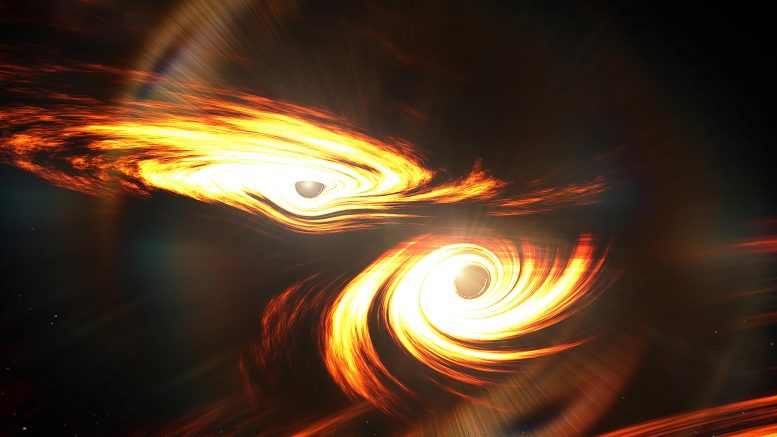An artist’s impression of two black holes about to collide and merge.
Findings by the Center for Computational Relativity and Gravitation published in Nature Astronomy.
For the first time, scientists believe they have detected a merger of two black holes with eccentric orbits. According to a paper published in Nature Astronomy by researchers from Rochester Institute of Technology’s Center for Computational Relativity and Gravitation and the
Artist’s impression of binary black holes about to collide. Credit: Mark Myers, ARC Centre of Excellence for Gravitational Wave Discovery (OzGrav)
A team of RIT researchers including Lousto, Research Associate James Healy, Jacob Lange ’20 Ph.D. (astrophysical sciences and technology), Professor and CCRG Director Manuela Campanelli, Associate Professor Richard O’Shaughnessy, and collaborators from the University of Florida formed to give a fresh look at the data to see if the black holes had highly eccentric orbits before they merged. They found the merger is best explained by a high-eccentricity, precessing model. To achieve this, the team performed hundreds of new full numerical simulations in local and national lab supercomputers, taking nearly a year to complete.
“This represents a major advancement in our understanding of how black holes merge,” said Campanelli. “Through our sophisticated supercomputer simulations and the wealth of new data provided by LIGO and Virgo’s rapidly advancing detectors, we are making new discoveries about the universe at astonishing rates.”
An extension of this analysis by the same RIT and UFL team used a possible electromagnetic counterpart observed by the Zwicky Transient Facility to compute independently the cosmological Hubble constant with GW150521 as an eccentric binary black hole merger. They found excellent agreement with the expected values and recently published the work in the Astrophysical Journal.
Reference: “Eccentricity estimate for black hole mergers with numerical relativity simulations” by V. Gayathri, J. Healy, J. Lange, B. O’Brien, M. Szczepanczyk, Imre Bartos, M. Campanelli, S. Klimenko, C. O. Lousto and R. O’Shaughnessy, 20 January 2022, Nature Astronomy.
DOI: 10.1038/s41550-021-01568-w
